同位语从句讲解
- 格式:docx
- 大小:15.53 KB
- 文档页数:5
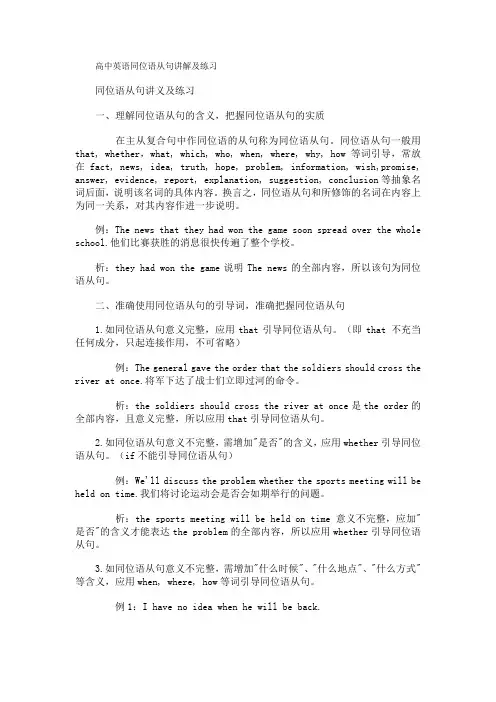
高中英语同位语从句讲解及练习同位语从句讲义及练习一、理解同位语从句的含义,把握同位语从句的实质在主从复合句中作同位语的从句称为同位语从句。
同位语从句一般用that, whether,what, which, who, when, where, why, how 等词引导,常放在fact, news, idea, truth, hope, problem, information, wish,promise, answer, evidence, report, explanation, suggestion, conclusion等抽象名词后面,说明该名词的具体内容。
换言之,同位语从句和所修饰的名词在内容上为同一关系,对其内容作进一步说明。
例:The news that they had won the game soon spread over the whole school.他们比赛获胜的消息很快传遍了整个学校。
析:they had won the game说明The news的全部内容,所以该句为同位语从句。
二、准确使用同位语从句的引导词,准确把握同位语从句1.如同位语从句意义完整,应用that引导同位语从句。
(即that 不充当任何成分,只起连接作用,不可省略)例:The general gave the order that the soldiers should cross the river at once.将军下达了战士们立即过河的命令。
析:the soldiers should cross the river at once是the order的全部内容,且意义完整,所以应用that引导同位语从句。
2.如同位语从句意义不完整,需增加"是否"的含义,应用whether引导同位语从句。
(if不能引导同位语从句)例:We'll discuss the problem whether the sports meeting will be held on time.我们将讨论运动会是否会如期举行的问题。
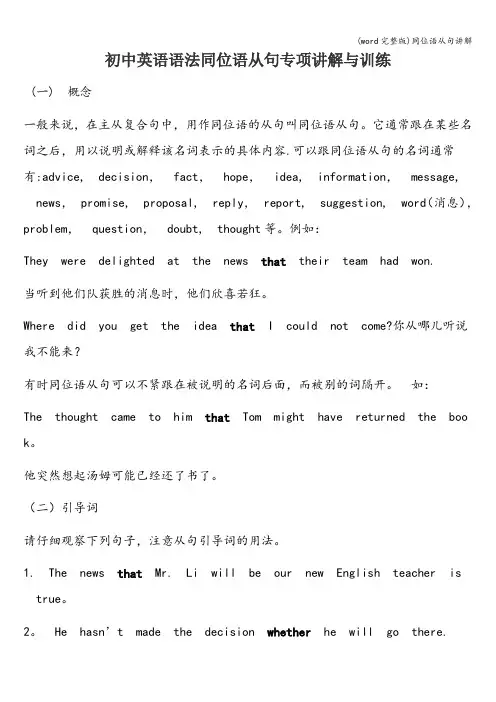
初中英语语法同位语从句专项讲解与训练(一) 概念一般来说,在主从复合句中,用作同位语的从句叫同位语从句。
它通常跟在某些名词之后,用以说明或解释该名词表示的具体内容.可以跟同位语从句的名词通常有:advice, decision,fact,hope,idea, information,message, news,promise, proposal, reply,report, suggestion, word(消息),problem,question,doubt, thought等。
例如:They were delighted at the news that their team had won.当听到他们队获胜的消息时,他们欣喜若狂。
Where did you get the idea that I could not come?你从哪儿听说我不能来?有时同位语从句可以不紧跟在被说明的名词后面,而被别的词隔开。
如:The thought came to him that Tom might have returned the boo k。
他突然想起汤姆可能已经还了书了。
(二)引导词请仔细观察下列句子,注意从句引导词的用法。
1. The news that Mr. Li will be our new English teacher istrue。
2。
He hasn’t made the decision whether he will go there.3。
The question who should do the work is being discussed a t the meeting4. I have no idea what the boy is doing in the next room now.5. We haven’t yet settled the question where we are going t o spend our summer vacation this year。
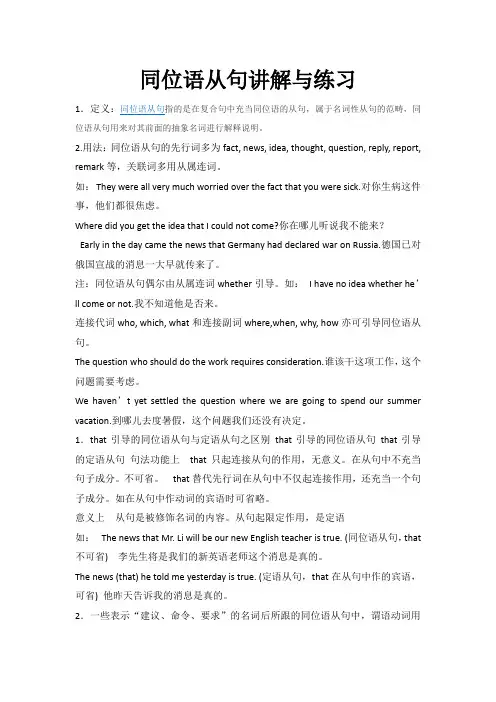
同位语从句讲解与练习1位语从句用来对其前面的抽象名词进行解释说明。
2.用法:同位语从句的先行词多为fact, news, idea, thought, question, reply, report, remark等,关联词多用从属连词。
如:They were all very much worried over the fact that you were sick.对你生病这件事,他们都很焦虑。
Where did you get the idea that I could not come?你在哪儿听说我不能来?Early in the day came the news that Germany had declared war on Russia.德国已对俄国宣战的消息一大早就传来了。
注:同位语从句偶尔由从属连词whether引导。
如:I have no idea whether he’ll come or not.我不知道他是否来。
连接代词who, which, what和连接副词where,when, why, how亦可引导同位语从句。
The question who should do the work requires consideration.谁该干这项工作,这个问题需要考虑。
We haven’t yet settled the question where we are going to spend our summer vacation.到哪儿去度暑假,这个问题我们还没有决定。
1.that引导的同位语从句与定语从句之区别that引导的同位语从句that引导的定语从句句法功能上that只起连接从句的作用,无意义。
在从句中不充当句子成分。
不可省。
that替代先行词在从句中不仅起连接作用,还充当一个句子成分。
如在从句中作动词的宾语时可省略。
意义上从句是被修饰名词的内容。
从句起限定作用,是定语如:The news that Mr. Li will be our new English teacher is true. (同位语从句,that 不可省) 李先生将是我们的新英语老师这个消息是真的。
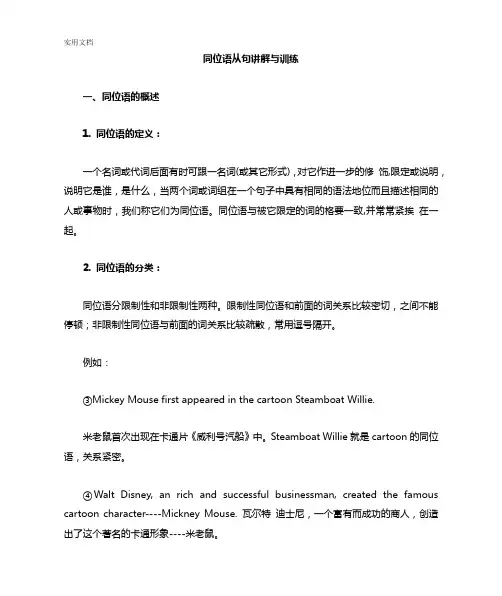
同位语从句讲解与训练一、同位语的概述1. 同位语的定义:一个名词或代词后面有时可跟一名词(或其它形式),对它作进一步的修饰,限定或说明,说明它是谁,是什么,当两个词或词组在一个句子中具有相同的语法地位而且描述相同的人或事物时,我们称它们为同位语。
同位语与被它限定的词的格要一致,并常常紧挨在一起。
2. 同位语的分类:同位语分限制性和非限制性两种。
限制性同位语和前面的词关系比较密切,之间不能停顿;非限制性同位语与前面的词关系比较疏散,常用逗号隔开。
例如:③Mickey Mouse first appeared in the cartoon Steamboat Willie.米老鼠首次出现在卡通片《威利号汽船》中。
Steamboat Willie就是cartoon的同位语,关系紧密。
④Walt Disney, an rich and successful businessman, created the famous cartoon character----Mickney Mouse. 瓦尔特迪士尼,一个富有而成功的商人,创造出了这个著名的卡通形象----米老鼠。
an rich and successful man 是主语Walt Disney的同位语,句子中有没有它,无所谓,不影响理解。
而且“瓦尔特迪士尼”是个“富有而成功的商人”,反过来,“一个富有而成功的商人”可不一定就是“瓦尔特迪士尼”。
3. 同位语的形式:(1)名词用作同位语时最多:①This is Mr.Brown,our Spanish teacher.这是我们的西班牙语老师布朗先生。
②“Leave it to me,”said Lao He,the man on night duty.值夜班的人老何说:“这事交给我。
”③You girls may take those seats over there.你们姑娘们可以坐在那边的座位上。
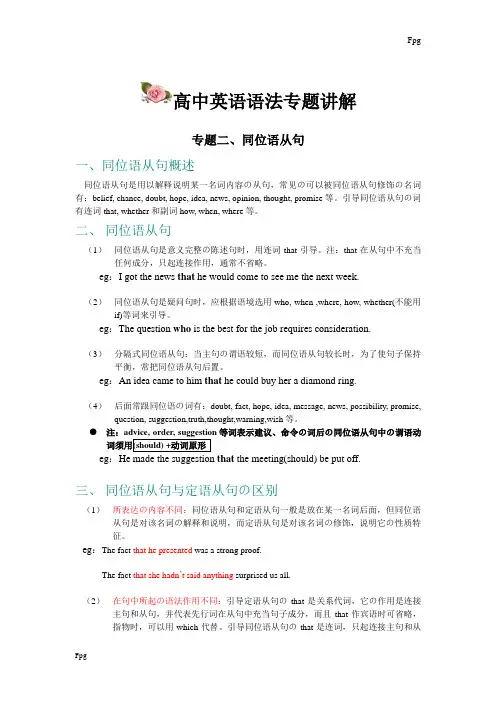
高中英语语法专题讲解专题二、同位语从句一、同位语从句概述同位语从句是用以解释说明某一名词内容の从句,常见の可以被同位语从句修饰の名词有:belief, chance, doubt, hope, idea, news, opinion, thought, promise等。
引导同位语从句の词有连词that, whether和副词how, when, where等。
二、同位语从句(1)同位语从句是意义完整の陈述句时,用连词that引导。
注:that在从句中不充当任何成分,只起连接作用,通常不省略。
eg:I got the news that he would come to see me the next week.(2)同位语从句是疑问句时,应根据语境选用who, when ,where, how, whether(不能用if)等词来引导。
eg:The question who is the best for the job requires consideration.(3)分隔式同位语从句:当主句の谓语较短,而同位语从句较长时,为了使句子保持平衡,常把同位语从句后置。
eg:An idea came to him that he could buy her a diamond ring.(4)后面常跟同位语の词有:doubt, fact, hope, idea, message, news, possibility, promise, question, suggestion,truth,thought,warning,wish等。
●注:advice, order, suggestion等词表示建议、命令の词后の同位语从句中の谓语动eg: that the meeting(should) be put off.三、同位语从句与定语从句の区别(1)所表达の内容不同:同位语从句和定语从句一般是放在某一名词后面,但同位语从句是对该名词の解释和说明,而定语从句是对该名词の修饰,说明它の性质特征。
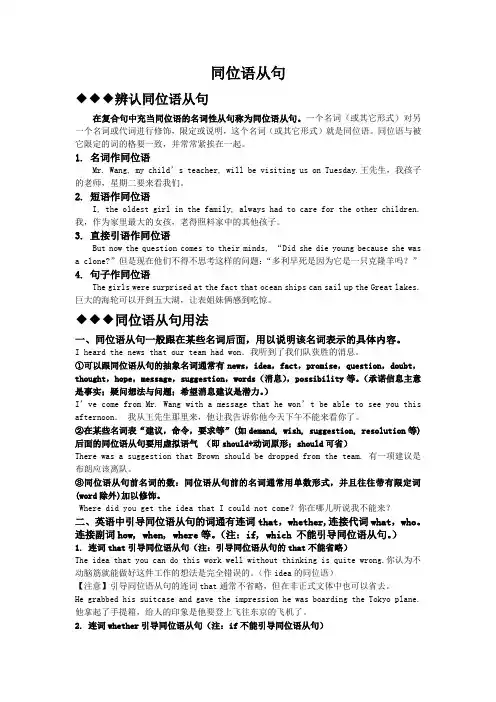
同位语从句◆◆◆辨认同位语从句在复合句中充当同位语的名词性从句称为同位语从句。
一个名词(或其它形式)对另一个名词或代词进行修饰,限定或说明,这个名词(或其它形式)就是同位语。
同位语与被它限定的词的格要一致,并常常紧挨在一起。
1. 名词作同位语Mr. Wang, my child’s teacher, will be visiting us on Tuesday.王先生,我孩子的老师,星期二要来看我们。
2. 短语作同位语I, the oldest girl in the family, always had to care for the other children.我,作为家里最大的女孩,老得照料家中的其他孩子。
3. 直接引语作同位语But now the question comes to their minds, “Did she die young because she wasa clone?”但是现在他们不得不思考这样的问题:“多利早死是因为它是一只克隆羊吗?”4. 句子作同位语The girls were surprised at the fact that ocean ships can sail up the Great lakes.巨大的海轮可以开到五大湖,让表姐妹俩感到吃惊。
◆◆◆同位语从句用法一、同位语从句一般跟在某些名词后面,用以说明该名词表示的具体内容。
I heard the news that our team had won.我听到了我们队获胜的消息。
①可以跟同位语从句的抽象名词通常有news,idea,fact,promise,question,doubt,thought,hope,message,suggestion,words(消息),possibility等。
(承诺信息主意是事实;疑问想法与问题;希望消息建议是潜力。
)I’ve come from Mr. Wang with a message that he won’t be able to see you this afternoon.我从王先生那里来,他让我告诉你他今天下午不能来看你了。

同位语从句同位语从句1.什么是同位语从句?在主从复合句中作同位语的从句称为同位语从句,常放在fact, news, idea, truth, hope, problem, information, wish,promise, answer, evidence, report, explanation, suggestion, conclusion等抽象名词后面,说明该名词的具体内容。
换言之,同位语从句和所修饰的名词在内容上为同一关系,对其内容作进一步说明。
例:The news that they had won the game soon spread over the whole school.他们比赛获胜的消息很快传遍了整个学校。
析:they had won the game说明The news的全部内容,因此该句为同位语从句。
2.引导词有哪些?怎么用?同位语从句一般用that, whether,what, which, who, when, where, why, how等词引导。
(补充:whether, what, how 不能引导定语从句,但可以用在同位语从句)补充:when,where 和 why 引导的定语从句和同位语从句之区别:when , where 和 why 作关系副词引导定语从句时,有跟它们含义相应的先行词,且先行词在从句中充当一定成分。
当 when , where 和 why作连接副词引导同位语从句时,则没有与它们含义相应的先行词。
所以,只要看先行词就可以判定了,若先行词和引导词关系密切,就是定从;只是修饰关系,就是同位语从句。
试比较:I'll never forget the day when ( = on which ) we met for the first time . ( 定语从句 )I have no idea when we met for the first time ( 同位语从句 )The office where ( = in which ) you work is here . ( 定语从句 )Then arose the question where we were to get so much money . ( 同位语从句 ) The reason why ( = for which ) he did not come is quite clear . ( 定语从句 )Xiao Wang has solved the problem why the TV was out of order . ( 同位语从句 )以上例句中 when , where 和 why 作关系副词引导定语从句时,可以改为“介词 + 关系代词 which ”来引导;而引导同位语从句的 when , where 和 why 就不能这样改。
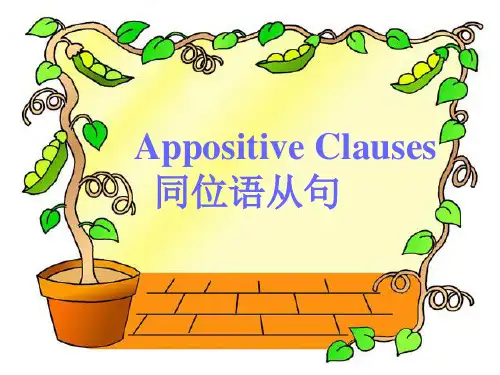
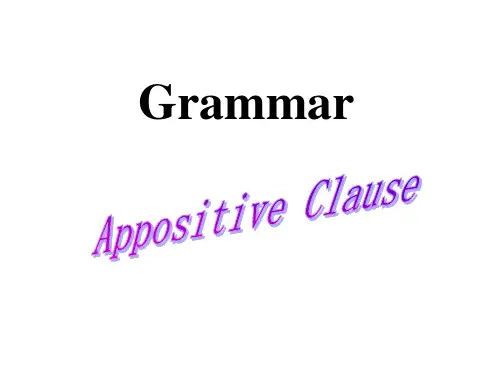
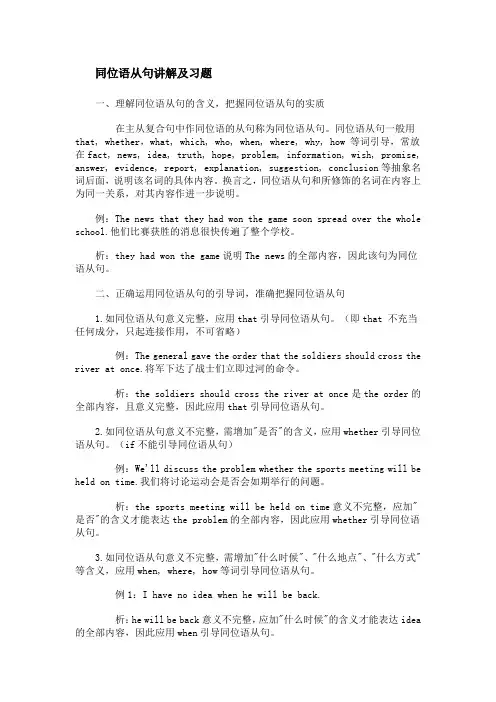
同位语从句讲解及习题一、理解同位语从句的含义,把握同位语从句的实质在主从复合句中作同位语的从句称为同位语从句。
同位语从句一般用that, whether,what, which, who, when, where, why, how 等词引导,常放在fact, news, idea, truth, hope, problem, information, wish, promise, answer, evidence, report, explanation, suggestion, conclusion等抽象名词后面,说明该名词的具体内容。
换言之,同位语从句和所修饰的名词在内容上为同一关系,对其内容作进一步说明。
例:The news that they had won the game soon spread over the whole school.他们比赛获胜的消息很快传遍了整个学校。
析:they had won the game说明The news的全部内容,因此该句为同位语从句。
二、正确运用同位语从句的引导词,准确把握同位语从句1.如同位语从句意义完整,应用that引导同位语从句。
(即that 不充当任何成分,只起连接作用,不可省略)例:The general gave the order that the soldiers should cross the river at once.将军下达了战士们立即过河的命令。
析:the soldiers should cross the river at once是the order的全部内容,且意义完整,因此应用that引导同位语从句。
2.如同位语从句意义不完整,需增加"是否"的含义,应用whether引导同位语从句。
(if不能引导同位语从句)例:We'll discuss the problem whether the sports meeting will be held on time.我们将讨论运动会是否会如期举行的问题。
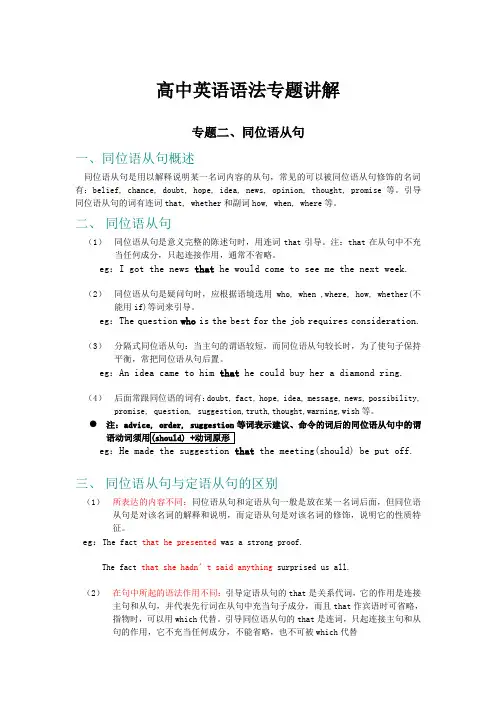
高中英语语法专题讲解专题二、同位语从句一、同位语从句概述同位语从句是用以解释说明某一名词内容的从句,常见的可以被同位语从句修饰的名词有:belief, chance, doubt, hope, idea, news, opinion, thought, promise等。
引导同位语从句的词有连词that, whether和副词how, when, where等。
二、同位语从句(1)同位语从句是意义完整的陈述句时,用连词that引导。
注:that在从句中不充当任何成分,只起连接作用,通常不省略。
eg:I got the news that he would come to see me the next week.(2)同位语从句是疑问句时,应根据语境选用who, when ,where, how, whether(不能用if)等词来引导。
eg:The question who is the best for the job requires consideration.(3)分隔式同位语从句:当主句的谓语较短,而同位语从句较长时,为了使句子保持平衡,常把同位语从句后置。
eg:An idea came to him that he could buy her a diamond ring.(4)后面常跟同位语的词有:doubt, fact, hope, idea, message, news, possibility, promise, question, suggestion,truth,thought,warning,wish等。
●注:advice, order, suggestion等词表示建议、命令的词后的同位语从句中的谓eg: the meeting(should) be put off.三、同位语从句与定语从句的区别(1)所表达的内容不同:同位语从句和定语从句一般是放在某一名词后面,但同位语从句是对该名词的解释和说明,而定语从句是对该名词的修饰,说明它的性质特征。
同位语从句讲解就是名词性从句(主语从句、表语从句、宾语从句、同位语从句)中的主要从句之一,从句作同位语表示与之同位的名词(短语)的实际内容,它的作用相当于名词,对前面的名词(短语)加以补充说明或进一步解释,相当于一个表语从句,它们之间的关系就是同位关系,即主表关系。
详细信息一个名词(或其它形式)对另一个名词或代词进行修饰,限定或说明,这个名词(或其它形式)就就是同位语。
同位语与被它限定的词的格要一致,并常常紧挨在一起。
1、名词作同位语Mr Wang, my chi ld’s teacher, will be visiting us on Tuesday、王先生,我孩子的老师,星期二要来瞧我们。
2、短语作同位语I, the oldest girl in the family, always had to care for the other children、我,作为家里最大的女孩,老得照料家中的其她孩子。
3、直接引语作同位语But now the question comes to their minds, “Did she die young because she was a clone?”但就是现在她们不得不思考这样的问题:“多莉早死就是因为它就是一只克隆羊不?” 4、句子作同位语The girls were surprised at the fact that ocean ships can sail up the Great lakes、巨大的海轮可以开到五大湖,让表姐妹俩感到吃惊。
同位语从句用法同位语部分就是个句子,就就是同位语从句,这种用法比较"固定"一、在复合句中用作同位语的从句叫同位语从句。
它一般跟在某些名词后面,用以说明该名词表示的具体内容。
I heard the news that our team had won.我听到了我们队获胜的消息。
二、可以跟同位语从句的名词通常有news,idea,fact,promise,question,doubt,thought,hope,message,suggestion,words(消息),possibility等。
同位语从句讲解同位语从句指的是在复合句中充当同位语的从句,可以对其前面的抽象名词做解释说明,属于名词性从句的范畴。
同位语从句的引导词为that,无含义,不充当成分,不可省略。
1. that引导同位语从句。
在下列名词后可用that引导同位语从句answer, belief, doubt, fact, hope, idea, information, knowledge, law, news, opinion, plan, suggestion, thought, truth等。
I had no idea that you were here.The story goes that William killed his wife.He always works hard in spite of the fact that he is not in good health.Suddenly the thought came to me that he would go blind.注意:①位语从句引导词that无含义,不充当成分,不可省略。
②同位语从句与其说明的名词或代词为同一内容,故可以用is把前边的中心词和从句连接成一个句子。
③同位语从句前一般没有逗号。
that引导同位语从句与引导定语从句的区别:that引导同位语从句时只起连接作用,不充当任何成分;that引导定语从句时,在从句中要作成分,如主语、宾语等。
①He told me the news that our team won.(that引导同位语从句)②The news that / which he told me was very exciting.(that引导定语从句,在从句中作宾语)2. 在no idea, question, problem等后可用wh-疑问词引导同位语从句,if不引导同位语从句。
I have no idea where he has gone.I have no idea what he said.3. 辨析:引导名词性从句时what与whatever, who与whoever 的区别:what 与whatever:What you want has been sent here.(what = the thing(s) that/all that/anything that特指)Whatever you want makes no difference to me.(whatever = anything that泛指)What caused the accident was a broken bottle.(特指)Whatever caused the accident has not yet been found.(泛指)who 与whoever:Who will go to Beijing on business has not been decided.(who表疑问,表示谁,哪一个)Whoever breaks the law should be punished.(whoever = anyone who,表示无论哪个人)4. 同位语从句注意与定语从句区别,同位语从句对前一名词做补充说明,在从句中无语法位置,而定语从句所修饰词在从句中占一语法位置如:The idea that one can do the work without thinking is wrong.(同位idea在从句中无位置,而从句只是具体说明idea的内容)The idea that you put forward at the meeting is wrong.(定语从句,idea做put forward 的宾语)。
同位语从句(用于写作很高端)+区别于定语从句和表语从句一.定义:即“同一个地位”:一个名词(或其它形式)对另一个名词或代词进行修饰,限定或说明,这个名词(或其它形式)就是同位语。
同位语与被它限定的词的格式一致,紧挨在一起。
1. 名词作同位语Mr. Wang, my child’s teacher, will be visiting us on Tuesday.王先生,我孩子的老师,星期二要来看我们。
2. 短语作同位语I, the oldest girl in the family, always had to care for the other children.我,作为家里最大的女孩,老得照料家中的其他孩子。
3. 直接引语作同位语But now the question comes to their minds, “Did she die young because she was a clone?”但是现在他们不得不思考这样的问题:“多利早死是因为它是一只克隆羊吗?”4. 句子作同位语The girls were surprised at the fact that ocean ships can sail up the Great lakes.巨大的海轮可以开到五大湖,让表姐妹俩感到吃惊。
二.同位语从句常见用法(判断标志)①抽象名词:news,idea,fact,promise,question,doubt,thought,hope,message,suggestion,words(消息),possibility②表“建议,命令,要求等”:demand, wish, suggestion, resolution等后面的同位语从句要用虚拟语气(即should+动词原形;should可省)There was a suggestion that Brown should be dropped from the team.有一项建议是布朗应离队。
初中英语语法同位语从句专项讲解与训练(一) 概念
一般来说,在主从复合句中,用作同位语的从句叫同位语从句。
它通常跟在某些名词之后,用以说明或解释该名词表示的具体内容。
可以跟同位语从句的名词通常有:
advice, decision, fact, hope, idea, information, message, news, promise, p roposal, reply, report, suggestion, word(消息),
problem, question, doubt, thought等。
例如:
They were delighted at the news that their team had won.
当听到他们队获胜的消息时,他们欣喜若狂。
Where did you get the idea that I could not come?你从哪儿听说我不能来?
有时同位语从句可以不紧跟在被说明的名词后面,而被别的词隔开。
如:
The thought came to him that Tom might have returned the book.
他突然想起汤姆可能已经还了书了。
(二)引导词
请仔细观察下列句子,注意从句引导词的用法。
1. The news that Mr. Li will be our new English teacher is true.
2. He hasn’t made the decision whether he will go there.
3. The question who should do the work is being discussed at the meeting
4. I have no idea what the boy is doing in the next room now.
5. We haven’t yet settled the question where we are going to spend our s ummer vacation this year.
6. I have no idea how I can get to the railway station.
7. I have no idea when he will be back.
[小结归纳]
① that引导同位语从句时无词义,也不充当任何成分,但通常不可以省略,如句1;
② whether引导同位语从句时意为“是否”,通常不能用if来代替,如句2;
③连接代词who, what等可以引导同位语从句,如句3, 4;
④连接副词where, how, when等可以引导同位语从句,如句5,6,7。
(三) that 引导的同位语从句和定语从句
①意义不同:同位语从句用来进一步说明前面名词的内容;而定语从句用来修饰、限定前面的先行词。
试比较:
1. The news that our team has won the final match is encouraging.
2. The news that you told us is really encouraging.
[分析] 句1中that引导同位语从句,说明“news”的内容:我们队取得了决赛胜利。
句2中that引导定语从句,对“news”加以限定:是你告诉我们的,而非来自其他渠道。
② that的功能不同:that引导同位语从句时是一个纯连词,不充当任何成分;而引导定语从句时,不仅起连接作用,而且还指代先行词并在从句中充当主语、宾语等成分。
试比较:
1. Dad made a promise that he would buy me a CD player if I passed the English test.
2. Dad made a promise that excited all his children.
[分析] 句1中 that引导同位语从句,其中that无词义,也不充当任何成分;句2中that引导定语从句,that指代promise,又在从句中充当主语,且that可以用which替换。
③可否省略:that在引导同位语从句时,通常不可省略。
在引导定语从句时,若在从句中作宾语,通常可以省略,若作主语则不可以省略。
[即学即用]
I.请用适当的词填空,使下列句子意思完整。
1. They expressed the hope _______ they would come over to China soon .
2. The fact _______ he didn’t see Tom this morning is true.
3. Word has come _______ some American guests will come to our colle -ge for a visit next week.
4. He can’t answer the question _______ he got the money from his home yesterday.
5. Do you have any idea _______ is actually going on in the classroom?
6. The problem _______ we should have the meeting in the hall now mus t be decided at once.
II. 下列各句中均有一处错误,请改正。
1. Our team has won the game, that made us very happy.
2. I’ve come with a message from Mr Wang how he won’t be able to see you this afternoon.
3. He must answer the question if he agrees with what she said or not.
4. I’ve read the book where you gave me the day before yesterday.
5. One of the men held the pinion when what the book said was right. III.把下列句子翻译成英语。
1. 我向他许诺说我一到北京就给他写信。
2. 他经常问我这个问题,那就是这个工作是否值得做。
3. 他什么也不说,这一事实使大家都感到惊奇。
4. 在我看来,他刚才告诉我的这个消息是真实的。
5. 他突然想起他本来应该去接儿子的。
Key:
I. 1. that 2. that 3. that 4. how 5. what
6. whether
II. 1 that→which 2. how→that 3. if→whether
4. where→that / which或省略where
5. when→that
6. that→how
III. 1. I made a promise that I would write to him as soon as I got to Beiji ng.
2. He often asked me the question whether the work was worth doing.
3. The fact that he had not said anything surprised everybody.
4. In my opinion, the news (that / which) he told me just now is true.
5. A thought suddenly came to him that he should have picked up his son.。